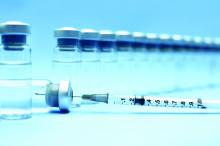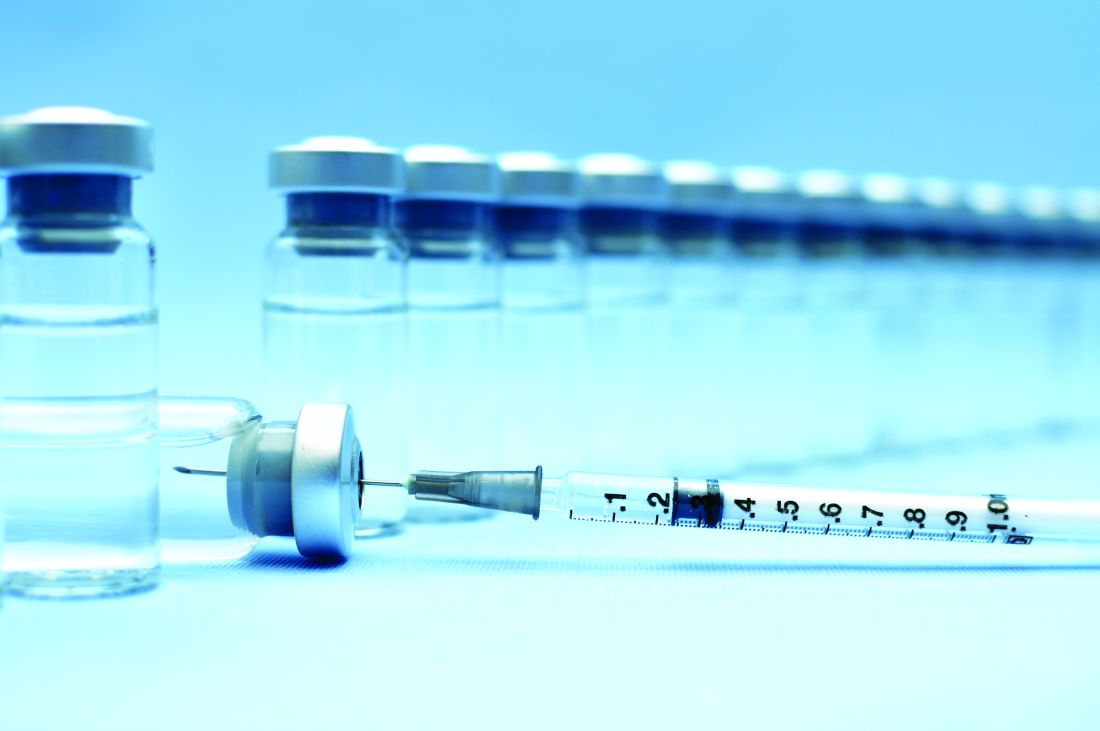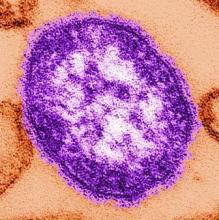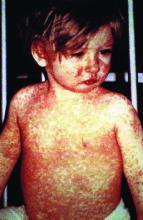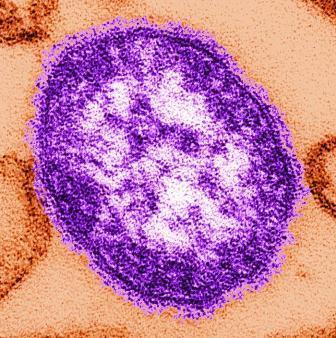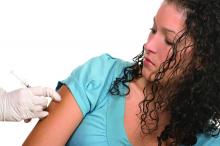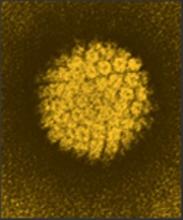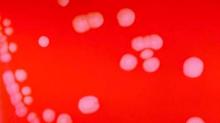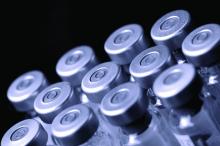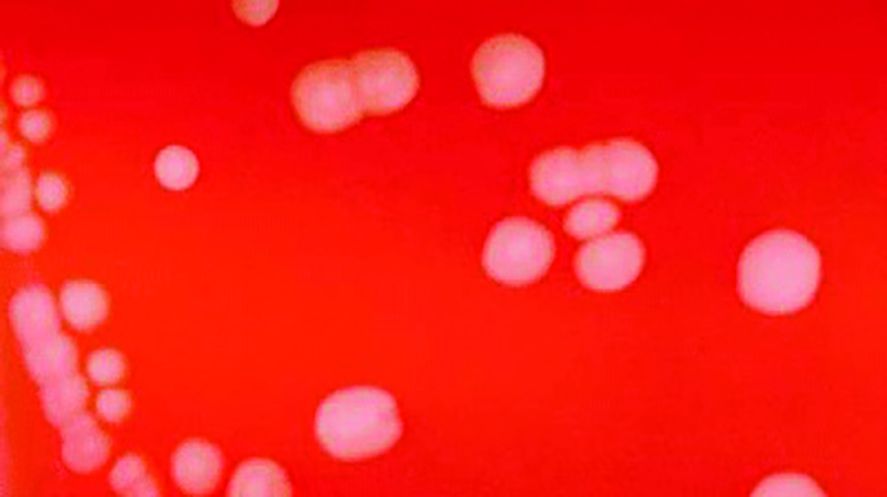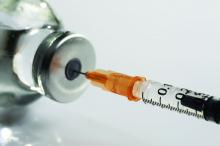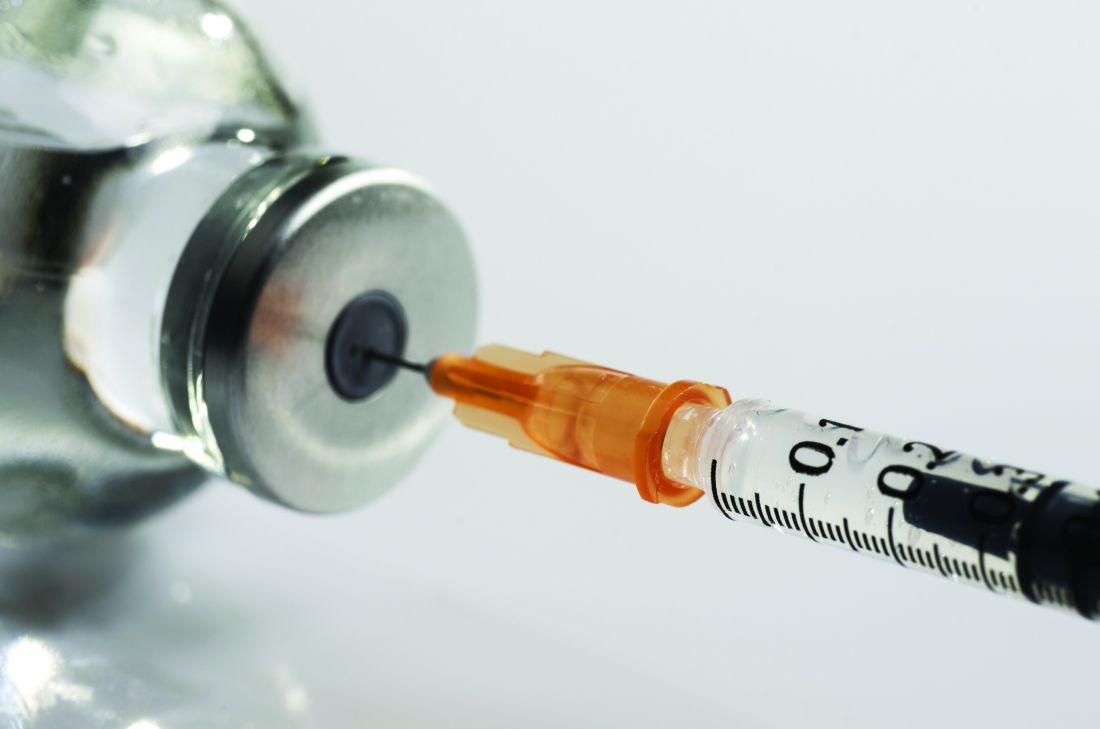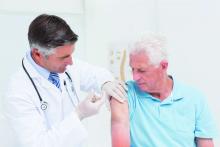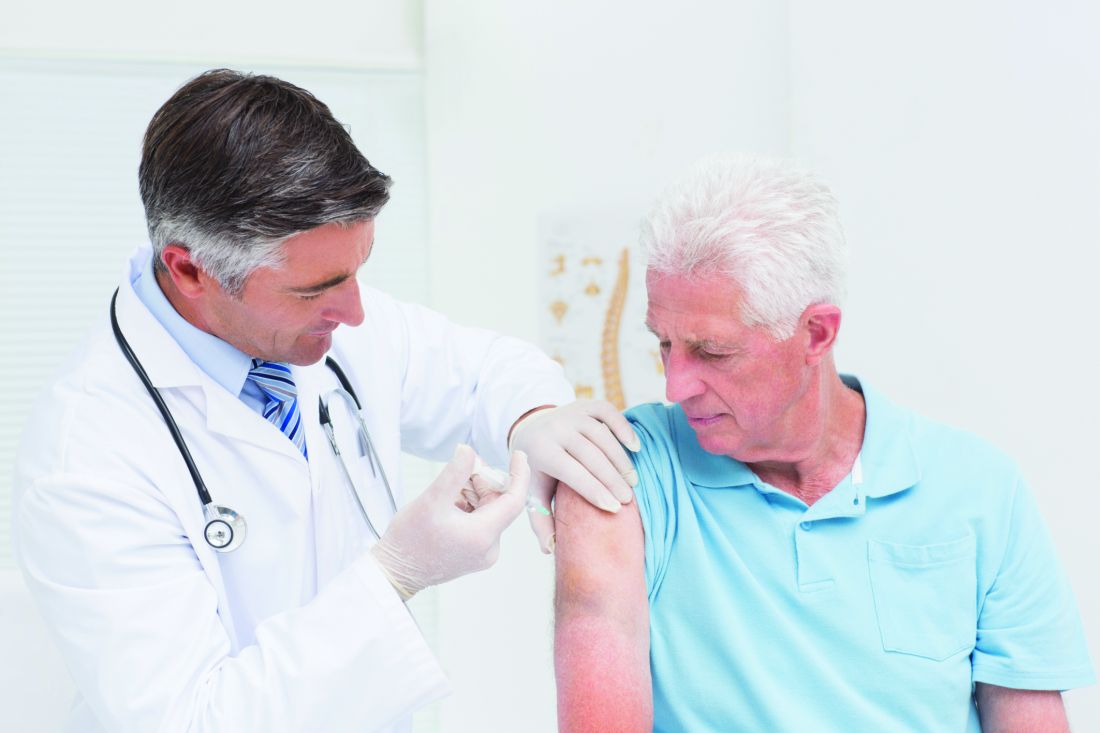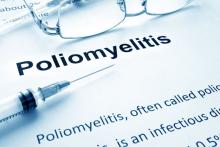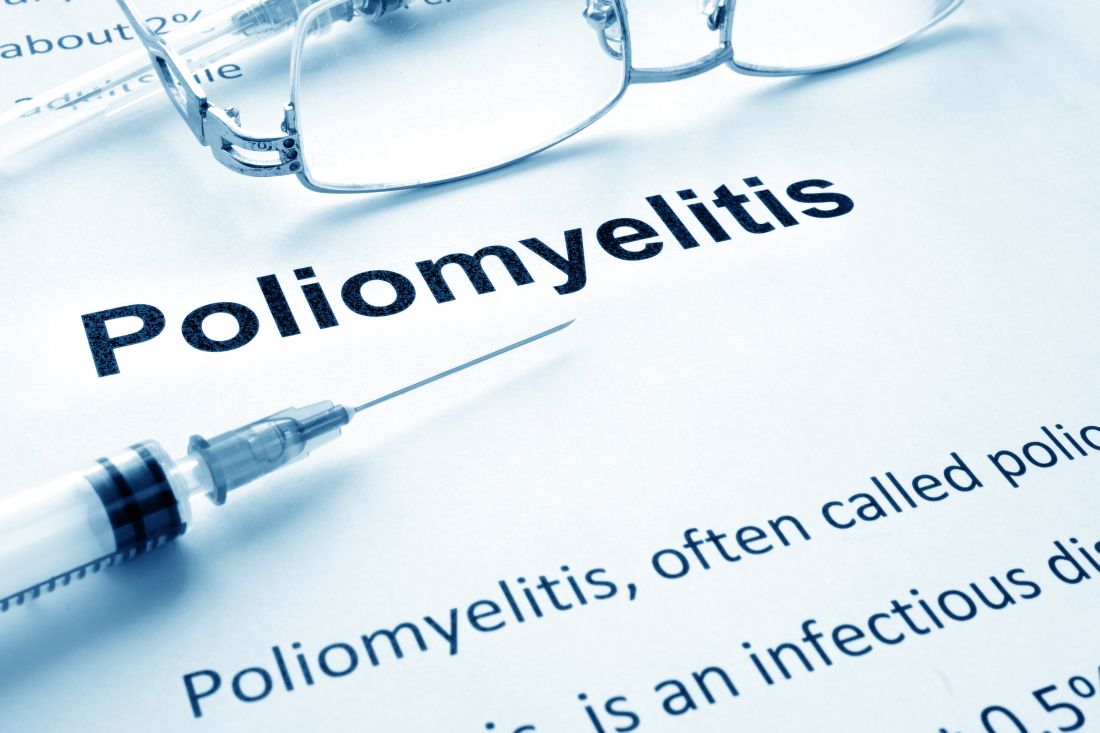User login
HPV vaccine training video improved provider knowledge, confidence
SAN FRANCISCO – Showing pediatric providers a 22-minute online training video about the human papillomavirus (HPV) vaccine and how to counsel families on it improved the providers’ knowledge, attitudes, and confidence in recommending the vaccine, according to a study.
“This video may be a cost-effective way to train providers across the nation to strongly recommend the HPV vaccine, which may ultimately impact vaccination rates,” lead author Maya Kumar, MD, of the University of California, San Diego, said at the Pediatric Academic Societies meeting.
Previous research has shown that one of the biggest obstacles to uptake of the HPV vaccine is the lack of a strong provider recommendation.
“Common reasons for this include inadequate knowledge of the impact of HPV-related disease, perceptions that the vaccine is less important for preteens or less important for boys, and discomfort with addressing parental concerns about the vaccine,” explained Dr. Kumar.
She therefore wanted to see whether a video addressing these concerns and knowledge gaps would improve providers’ knowledge, confidence, and their likelihood of strongly recommending the HPV vaccine to their clients.
The AAP California Chapter 3 created a 22-minute video that explains the burden of HPV-related disease, provides general information about the vaccine, and reviews common provider-related obstacles to vaccination (although not patient-related or systemic barriers). Then the video provides counseling strategies to help providers in improving HPV vaccine uptake at their clinic. Following the discussion of those strategies are eight clinical vignettes in which experienced pediatricians model those techniques with “patients” and “parents” played by actors.
The researchers then showed the video to 109 providers from four large pediatric practices in San Diego and the San Diego Immunization Coalition. The group included 47% of pediatricians and nurse practitioners, 25% of allied health professionals, 20% nurses and 7% of trainees.
Before viewing, the providers filled out a questionnaire assessing their knowledge and attitude toward the HPV vaccine and how they perceived their skill in recommending the vaccine. Then they filled out the same questionnaire after viewing the video.
Providers’ correct answers to questions on their knowledge about the vaccine all increased substantially after viewing the video. The biggest improvement was seen in response to the question about whether the vaccine’s efficacy changes with age. Before viewing the video, 49% of the providers knew that the immune response to the vaccine was stronger among younger recipients and that its efficacy dropped off as people reach their mid-20s. After seeing the video, 89% of providers correctly answered that question (P less than .01).
Another substantial improvement occurred for the question about HPV-related cancers’ prevalence in men. Before the video, 37% of providers answered correctly that a large proportion of these cancers do occur in men; after the video, 67% answered correctly (P less than .01).
The proportion of providers who correctly responded that HPV infects the majority of sexually active people increased from 85% to 90%. Similarly, those who knew HPV catch-up vaccination can be offered up until age 26 years increased from 88% to 96%, and those who knew HPV-related cancer is more prevalent than meningococcal disease increased from 91% to 97% (P less than .01 for all of these). The increase in providers who knew HPV infects the majority of sexually active people, from 85% to 97%, was the only one that didn’t reach statistical significance.
Similar improvements were seen in providers’ attitudes after viewing the video. On a Likert scale of 1 (strongly disagree) to 5 (strongly agree), statistically significant increases occurred for responding to whether it’s important to vaccinate girls against HPV (.07 increase) and the importance of the HPV vaccine for cancer protection rather than wart protection (.22 increase).
Likewise, statistically significant decreases occurred for whether it’s acceptable to delay the vaccine for a child before sexual debut (–0.38), whether it’s more important to give the Tdap and meningococcal vaccines than the HPV vaccines (–0.44), and whether the provider is concerned about short-term (–0.20) or long-term (–0.12) side effects of the vaccine.
Every one of the questions about providers’ skills improved statistically significantly, from increases of 0.19 to 0.66 points:
• Making a strong recommendation for the HPV vaccine.
• Discussing HPV vaccination again with a family who has previously declined it.
• Facilitating completion of a three-dose vaccine series once initiated.
• Presenting the HPV vaccine as a cancer-prevention vaccine.
• Addressing parental concerns about safety and side effects.
• Addressing parental concerns about HPV being sexually transmitted and the need to vaccinate before sexual debut.
• Counseling about the need to routinely vaccinate boys against HPV.
• Counseling about the rationale for routinely giving the HPV vaccine at age 11-12 years.
“There was positive feedback from the viewing providers, particularly about the use of clinical vignettes to model effective counseling strategies for recommending vaccination,” Dr. Kumar said.
She acknowledged that the results may not be generalizable to providers in other regions, and the study was unable to assess whether providers’ actual behavior or practice vaccination rates changed after viewing the video.
The study was funded by an American Academy of Pediatrics Adolescent Vaccinations and Wellness Education Grant, supported by Merck. Dr. Kumar had no relevant financial disclosures.
SAN FRANCISCO – Showing pediatric providers a 22-minute online training video about the human papillomavirus (HPV) vaccine and how to counsel families on it improved the providers’ knowledge, attitudes, and confidence in recommending the vaccine, according to a study.
“This video may be a cost-effective way to train providers across the nation to strongly recommend the HPV vaccine, which may ultimately impact vaccination rates,” lead author Maya Kumar, MD, of the University of California, San Diego, said at the Pediatric Academic Societies meeting.
Previous research has shown that one of the biggest obstacles to uptake of the HPV vaccine is the lack of a strong provider recommendation.
“Common reasons for this include inadequate knowledge of the impact of HPV-related disease, perceptions that the vaccine is less important for preteens or less important for boys, and discomfort with addressing parental concerns about the vaccine,” explained Dr. Kumar.
She therefore wanted to see whether a video addressing these concerns and knowledge gaps would improve providers’ knowledge, confidence, and their likelihood of strongly recommending the HPV vaccine to their clients.
The AAP California Chapter 3 created a 22-minute video that explains the burden of HPV-related disease, provides general information about the vaccine, and reviews common provider-related obstacles to vaccination (although not patient-related or systemic barriers). Then the video provides counseling strategies to help providers in improving HPV vaccine uptake at their clinic. Following the discussion of those strategies are eight clinical vignettes in which experienced pediatricians model those techniques with “patients” and “parents” played by actors.
The researchers then showed the video to 109 providers from four large pediatric practices in San Diego and the San Diego Immunization Coalition. The group included 47% of pediatricians and nurse practitioners, 25% of allied health professionals, 20% nurses and 7% of trainees.
Before viewing, the providers filled out a questionnaire assessing their knowledge and attitude toward the HPV vaccine and how they perceived their skill in recommending the vaccine. Then they filled out the same questionnaire after viewing the video.
Providers’ correct answers to questions on their knowledge about the vaccine all increased substantially after viewing the video. The biggest improvement was seen in response to the question about whether the vaccine’s efficacy changes with age. Before viewing the video, 49% of the providers knew that the immune response to the vaccine was stronger among younger recipients and that its efficacy dropped off as people reach their mid-20s. After seeing the video, 89% of providers correctly answered that question (P less than .01).
Another substantial improvement occurred for the question about HPV-related cancers’ prevalence in men. Before the video, 37% of providers answered correctly that a large proportion of these cancers do occur in men; after the video, 67% answered correctly (P less than .01).
The proportion of providers who correctly responded that HPV infects the majority of sexually active people increased from 85% to 90%. Similarly, those who knew HPV catch-up vaccination can be offered up until age 26 years increased from 88% to 96%, and those who knew HPV-related cancer is more prevalent than meningococcal disease increased from 91% to 97% (P less than .01 for all of these). The increase in providers who knew HPV infects the majority of sexually active people, from 85% to 97%, was the only one that didn’t reach statistical significance.
Similar improvements were seen in providers’ attitudes after viewing the video. On a Likert scale of 1 (strongly disagree) to 5 (strongly agree), statistically significant increases occurred for responding to whether it’s important to vaccinate girls against HPV (.07 increase) and the importance of the HPV vaccine for cancer protection rather than wart protection (.22 increase).
Likewise, statistically significant decreases occurred for whether it’s acceptable to delay the vaccine for a child before sexual debut (–0.38), whether it’s more important to give the Tdap and meningococcal vaccines than the HPV vaccines (–0.44), and whether the provider is concerned about short-term (–0.20) or long-term (–0.12) side effects of the vaccine.
Every one of the questions about providers’ skills improved statistically significantly, from increases of 0.19 to 0.66 points:
• Making a strong recommendation for the HPV vaccine.
• Discussing HPV vaccination again with a family who has previously declined it.
• Facilitating completion of a three-dose vaccine series once initiated.
• Presenting the HPV vaccine as a cancer-prevention vaccine.
• Addressing parental concerns about safety and side effects.
• Addressing parental concerns about HPV being sexually transmitted and the need to vaccinate before sexual debut.
• Counseling about the need to routinely vaccinate boys against HPV.
• Counseling about the rationale for routinely giving the HPV vaccine at age 11-12 years.
“There was positive feedback from the viewing providers, particularly about the use of clinical vignettes to model effective counseling strategies for recommending vaccination,” Dr. Kumar said.
She acknowledged that the results may not be generalizable to providers in other regions, and the study was unable to assess whether providers’ actual behavior or practice vaccination rates changed after viewing the video.
The study was funded by an American Academy of Pediatrics Adolescent Vaccinations and Wellness Education Grant, supported by Merck. Dr. Kumar had no relevant financial disclosures.
SAN FRANCISCO – Showing pediatric providers a 22-minute online training video about the human papillomavirus (HPV) vaccine and how to counsel families on it improved the providers’ knowledge, attitudes, and confidence in recommending the vaccine, according to a study.
“This video may be a cost-effective way to train providers across the nation to strongly recommend the HPV vaccine, which may ultimately impact vaccination rates,” lead author Maya Kumar, MD, of the University of California, San Diego, said at the Pediatric Academic Societies meeting.
Previous research has shown that one of the biggest obstacles to uptake of the HPV vaccine is the lack of a strong provider recommendation.
“Common reasons for this include inadequate knowledge of the impact of HPV-related disease, perceptions that the vaccine is less important for preteens or less important for boys, and discomfort with addressing parental concerns about the vaccine,” explained Dr. Kumar.
She therefore wanted to see whether a video addressing these concerns and knowledge gaps would improve providers’ knowledge, confidence, and their likelihood of strongly recommending the HPV vaccine to their clients.
The AAP California Chapter 3 created a 22-minute video that explains the burden of HPV-related disease, provides general information about the vaccine, and reviews common provider-related obstacles to vaccination (although not patient-related or systemic barriers). Then the video provides counseling strategies to help providers in improving HPV vaccine uptake at their clinic. Following the discussion of those strategies are eight clinical vignettes in which experienced pediatricians model those techniques with “patients” and “parents” played by actors.
The researchers then showed the video to 109 providers from four large pediatric practices in San Diego and the San Diego Immunization Coalition. The group included 47% of pediatricians and nurse practitioners, 25% of allied health professionals, 20% nurses and 7% of trainees.
Before viewing, the providers filled out a questionnaire assessing their knowledge and attitude toward the HPV vaccine and how they perceived their skill in recommending the vaccine. Then they filled out the same questionnaire after viewing the video.
Providers’ correct answers to questions on their knowledge about the vaccine all increased substantially after viewing the video. The biggest improvement was seen in response to the question about whether the vaccine’s efficacy changes with age. Before viewing the video, 49% of the providers knew that the immune response to the vaccine was stronger among younger recipients and that its efficacy dropped off as people reach their mid-20s. After seeing the video, 89% of providers correctly answered that question (P less than .01).
Another substantial improvement occurred for the question about HPV-related cancers’ prevalence in men. Before the video, 37% of providers answered correctly that a large proportion of these cancers do occur in men; after the video, 67% answered correctly (P less than .01).
The proportion of providers who correctly responded that HPV infects the majority of sexually active people increased from 85% to 90%. Similarly, those who knew HPV catch-up vaccination can be offered up until age 26 years increased from 88% to 96%, and those who knew HPV-related cancer is more prevalent than meningococcal disease increased from 91% to 97% (P less than .01 for all of these). The increase in providers who knew HPV infects the majority of sexually active people, from 85% to 97%, was the only one that didn’t reach statistical significance.
Similar improvements were seen in providers’ attitudes after viewing the video. On a Likert scale of 1 (strongly disagree) to 5 (strongly agree), statistically significant increases occurred for responding to whether it’s important to vaccinate girls against HPV (.07 increase) and the importance of the HPV vaccine for cancer protection rather than wart protection (.22 increase).
Likewise, statistically significant decreases occurred for whether it’s acceptable to delay the vaccine for a child before sexual debut (–0.38), whether it’s more important to give the Tdap and meningococcal vaccines than the HPV vaccines (–0.44), and whether the provider is concerned about short-term (–0.20) or long-term (–0.12) side effects of the vaccine.
Every one of the questions about providers’ skills improved statistically significantly, from increases of 0.19 to 0.66 points:
• Making a strong recommendation for the HPV vaccine.
• Discussing HPV vaccination again with a family who has previously declined it.
• Facilitating completion of a three-dose vaccine series once initiated.
• Presenting the HPV vaccine as a cancer-prevention vaccine.
• Addressing parental concerns about safety and side effects.
• Addressing parental concerns about HPV being sexually transmitted and the need to vaccinate before sexual debut.
• Counseling about the need to routinely vaccinate boys against HPV.
• Counseling about the rationale for routinely giving the HPV vaccine at age 11-12 years.
“There was positive feedback from the viewing providers, particularly about the use of clinical vignettes to model effective counseling strategies for recommending vaccination,” Dr. Kumar said.
She acknowledged that the results may not be generalizable to providers in other regions, and the study was unable to assess whether providers’ actual behavior or practice vaccination rates changed after viewing the video.
The study was funded by an American Academy of Pediatrics Adolescent Vaccinations and Wellness Education Grant, supported by Merck. Dr. Kumar had no relevant financial disclosures.
Key clinical point:
Major finding: Statistically significant improvements occurred among providers for five questions on HPV vaccine knowledge, six questions about attitudes toward the vaccine, and all eight questions concerning self-assessed skills in counseling families about the vaccine.
Data source: The findings are based on a cohort of 109 California pediatric providers whose knowledge, attitudes, and self-reported skills were assessed before and after the intervention.
Disclosures: The study was funded by an American Academy of Pediatrics Adolescent Vaccinations and Wellness Education Grant, supported by Merck. Dr. Kumar had no relevant financial disclosures.
Infants’ responses to multiple vaccines affected by maternal antibodies
Maternal antibody concentrations continue to affect children’s immune response to their first and later vaccine doses as late as age 2 years, according to study findings.
Greater spacing between doses did not eliminate the maternal antibody effects, the research published in JAMA Pediatrics showed.
“Our analysis comprehensively models the effects of maternal antibody inhibition and infant age at vaccination on the majority of vaccine antigens contained in current global infant immunization programs and reveals that, for almost all antigens, transplacental antibody inhibits the antibody response to priming vaccinations,” wrote Merryn Voysey of the University of Oxford (England), and her associates.
Booster doses do not diminish the effect, the authors add. “These analyses further reveal the benefit of infants being older when first immunized, an association that remains after adjusting for waning maternal antibody levels” (JAMA Pediatrics. 2017 May 15. doi: 10.1001/jamapediatrics.2017.0638).
Although the blunting from maternal antibodies has been long understood for the measles vaccine, this new study showed that even conjugate vaccines have this blunting in infancy, both due to “preexisting antibodies to the polysaccharide antigen [and] from antibodies associated with carrier proteins,” the authors wrote, referring to findings related to pneumococcal conjugate vaccines.
“Therefore, prenatal immunization programs containing multicomponent vaccines have the potential to interfere with the immunogenicity of current immunization programs,” Ms. Voysey and her colleagues wrote.
The authors requested and then analyzed deidentified participant data from GlaxoSmithKline vaccine immunogenicity clinical trials in which antibody concentration data were available before and after infants’ first vaccine dose. The analysis included 7,630 infants enrolled in 32 studies in 17 countries from Europe, Africa, Latin America, East Asia, Russia, and Australia. About half were boys, and infants’ mean age at baseline was 9 weeks.
The researchers found that infants’ antibody responses were blunted for 20 of 21 antigens due to maternal antibodies they still had. The inactivated polio vaccine was affected the most: a maternal antibody twice as high as other infants’ resulted in a 20% lower antibody geometric mean ratio for type 1 and a 28% lower antibody geometric mean ratio for type 2 after vaccination.
All three vaccines in the DTaP showed inhibited responses as well. Having twice as high a maternal antibody for acellular pertussis antigens resulted in an 11% reduction in infants’ antibody for both pertussis toxoid and filamentous hemagglutinin. Antibody for pertactin was 22% lower. Double the maternal antibody for tetanus translated to 13% lower response, and diphtheria antibody was similarly 24% lower.
Even at 12-24 months, children showed a blunted response due to maternal antibodies for the acellular pertussis, inactivated polio, and diphtheria vaccines. For each additional month of age children were when first immunized, their antibody response ranged from 10%-71% greater for 18 of 21 antigens, after accounting for the influence of maternal antibodies.
“In contrast to previous reports, the effects of maternal antibodies and the infant’s age when first immunized are not only seen in response to a priming series of vaccines, but continue to affect antibody responses to booster vaccinations at ages 12 to 24 months for many antigens,” the authors reported. “This finding suggests the importance of the quality of the immune response to the first dose of antigen, regardless of subsequent doses.”
For example, delaying administration of a first vaccine dose by 2-5 weeks resulted in offsetting a two- to fivefold greater concentration of maternal pertussis antibodies. To offset similarly higher maternal antibody concentrations for the other components of the DTaP would require a delay of 3-6 weeks for diphtheria and 2-4 weeks for tetanus.
The research funding came from the National Institute for Health Research via a fellowship of one author and salary support of another. Ms. Voysey had no relevant financial disclosures. Most of her colleagues received research grants or other assistance from pharmaceutical companies.
Maternal antibody concentrations continue to affect children’s immune response to their first and later vaccine doses as late as age 2 years, according to study findings.
Greater spacing between doses did not eliminate the maternal antibody effects, the research published in JAMA Pediatrics showed.
“Our analysis comprehensively models the effects of maternal antibody inhibition and infant age at vaccination on the majority of vaccine antigens contained in current global infant immunization programs and reveals that, for almost all antigens, transplacental antibody inhibits the antibody response to priming vaccinations,” wrote Merryn Voysey of the University of Oxford (England), and her associates.
Booster doses do not diminish the effect, the authors add. “These analyses further reveal the benefit of infants being older when first immunized, an association that remains after adjusting for waning maternal antibody levels” (JAMA Pediatrics. 2017 May 15. doi: 10.1001/jamapediatrics.2017.0638).
Although the blunting from maternal antibodies has been long understood for the measles vaccine, this new study showed that even conjugate vaccines have this blunting in infancy, both due to “preexisting antibodies to the polysaccharide antigen [and] from antibodies associated with carrier proteins,” the authors wrote, referring to findings related to pneumococcal conjugate vaccines.
“Therefore, prenatal immunization programs containing multicomponent vaccines have the potential to interfere with the immunogenicity of current immunization programs,” Ms. Voysey and her colleagues wrote.
The authors requested and then analyzed deidentified participant data from GlaxoSmithKline vaccine immunogenicity clinical trials in which antibody concentration data were available before and after infants’ first vaccine dose. The analysis included 7,630 infants enrolled in 32 studies in 17 countries from Europe, Africa, Latin America, East Asia, Russia, and Australia. About half were boys, and infants’ mean age at baseline was 9 weeks.
The researchers found that infants’ antibody responses were blunted for 20 of 21 antigens due to maternal antibodies they still had. The inactivated polio vaccine was affected the most: a maternal antibody twice as high as other infants’ resulted in a 20% lower antibody geometric mean ratio for type 1 and a 28% lower antibody geometric mean ratio for type 2 after vaccination.
All three vaccines in the DTaP showed inhibited responses as well. Having twice as high a maternal antibody for acellular pertussis antigens resulted in an 11% reduction in infants’ antibody for both pertussis toxoid and filamentous hemagglutinin. Antibody for pertactin was 22% lower. Double the maternal antibody for tetanus translated to 13% lower response, and diphtheria antibody was similarly 24% lower.
Even at 12-24 months, children showed a blunted response due to maternal antibodies for the acellular pertussis, inactivated polio, and diphtheria vaccines. For each additional month of age children were when first immunized, their antibody response ranged from 10%-71% greater for 18 of 21 antigens, after accounting for the influence of maternal antibodies.
“In contrast to previous reports, the effects of maternal antibodies and the infant’s age when first immunized are not only seen in response to a priming series of vaccines, but continue to affect antibody responses to booster vaccinations at ages 12 to 24 months for many antigens,” the authors reported. “This finding suggests the importance of the quality of the immune response to the first dose of antigen, regardless of subsequent doses.”
For example, delaying administration of a first vaccine dose by 2-5 weeks resulted in offsetting a two- to fivefold greater concentration of maternal pertussis antibodies. To offset similarly higher maternal antibody concentrations for the other components of the DTaP would require a delay of 3-6 weeks for diphtheria and 2-4 weeks for tetanus.
The research funding came from the National Institute for Health Research via a fellowship of one author and salary support of another. Ms. Voysey had no relevant financial disclosures. Most of her colleagues received research grants or other assistance from pharmaceutical companies.
Maternal antibody concentrations continue to affect children’s immune response to their first and later vaccine doses as late as age 2 years, according to study findings.
Greater spacing between doses did not eliminate the maternal antibody effects, the research published in JAMA Pediatrics showed.
“Our analysis comprehensively models the effects of maternal antibody inhibition and infant age at vaccination on the majority of vaccine antigens contained in current global infant immunization programs and reveals that, for almost all antigens, transplacental antibody inhibits the antibody response to priming vaccinations,” wrote Merryn Voysey of the University of Oxford (England), and her associates.
Booster doses do not diminish the effect, the authors add. “These analyses further reveal the benefit of infants being older when first immunized, an association that remains after adjusting for waning maternal antibody levels” (JAMA Pediatrics. 2017 May 15. doi: 10.1001/jamapediatrics.2017.0638).
Although the blunting from maternal antibodies has been long understood for the measles vaccine, this new study showed that even conjugate vaccines have this blunting in infancy, both due to “preexisting antibodies to the polysaccharide antigen [and] from antibodies associated with carrier proteins,” the authors wrote, referring to findings related to pneumococcal conjugate vaccines.
“Therefore, prenatal immunization programs containing multicomponent vaccines have the potential to interfere with the immunogenicity of current immunization programs,” Ms. Voysey and her colleagues wrote.
The authors requested and then analyzed deidentified participant data from GlaxoSmithKline vaccine immunogenicity clinical trials in which antibody concentration data were available before and after infants’ first vaccine dose. The analysis included 7,630 infants enrolled in 32 studies in 17 countries from Europe, Africa, Latin America, East Asia, Russia, and Australia. About half were boys, and infants’ mean age at baseline was 9 weeks.
The researchers found that infants’ antibody responses were blunted for 20 of 21 antigens due to maternal antibodies they still had. The inactivated polio vaccine was affected the most: a maternal antibody twice as high as other infants’ resulted in a 20% lower antibody geometric mean ratio for type 1 and a 28% lower antibody geometric mean ratio for type 2 after vaccination.
All three vaccines in the DTaP showed inhibited responses as well. Having twice as high a maternal antibody for acellular pertussis antigens resulted in an 11% reduction in infants’ antibody for both pertussis toxoid and filamentous hemagglutinin. Antibody for pertactin was 22% lower. Double the maternal antibody for tetanus translated to 13% lower response, and diphtheria antibody was similarly 24% lower.
Even at 12-24 months, children showed a blunted response due to maternal antibodies for the acellular pertussis, inactivated polio, and diphtheria vaccines. For each additional month of age children were when first immunized, their antibody response ranged from 10%-71% greater for 18 of 21 antigens, after accounting for the influence of maternal antibodies.
“In contrast to previous reports, the effects of maternal antibodies and the infant’s age when first immunized are not only seen in response to a priming series of vaccines, but continue to affect antibody responses to booster vaccinations at ages 12 to 24 months for many antigens,” the authors reported. “This finding suggests the importance of the quality of the immune response to the first dose of antigen, regardless of subsequent doses.”
For example, delaying administration of a first vaccine dose by 2-5 weeks resulted in offsetting a two- to fivefold greater concentration of maternal pertussis antibodies. To offset similarly higher maternal antibody concentrations for the other components of the DTaP would require a delay of 3-6 weeks for diphtheria and 2-4 weeks for tetanus.
The research funding came from the National Institute for Health Research via a fellowship of one author and salary support of another. Ms. Voysey had no relevant financial disclosures. Most of her colleagues received research grants or other assistance from pharmaceutical companies.
FROM JAMA PEDIATRICS
Key clinical point:
Major finding: Infants’ antibody concentrations after vaccination were inhibited for 20 of 21 antigens after a first dose and for 18 of 21 antigens up to 24 months later.
Data source: The findings are based on an analysis of pre- and postimmunization antibody concentrations to 21 vaccine antigens in 7,630 infants enrolled in 32 immunogenicity clinical studies in 17 countries.
Disclosures: The research funding came from the National Institute for Health Research via a fellowship of one author and salary support of another. Ms. Voysey had no relevant financial disclosures. Most of her colleagues received research grants or other assistance from pharmaceutical companies.
Aerosolized MMR vaccine showed good seropositivity
Aerosolized MMR vaccine can be used in booster campaigns in school-age children for measles and rubella, said José Luis Díaz Ortega, MD, of the Instituto Nacional de Salud Pública, Mexico, and his associates.
However, more studies of school-age children with longer follow-up of mumps antibody persistence are needed, they said.
Aerosolized vaccines are not available in the United States.
Read more in the journal Vaccine (2017 Apr 28. doi: 10.1016/j.vaccine.2017.04.027).
Aerosolized MMR vaccine can be used in booster campaigns in school-age children for measles and rubella, said José Luis Díaz Ortega, MD, of the Instituto Nacional de Salud Pública, Mexico, and his associates.
However, more studies of school-age children with longer follow-up of mumps antibody persistence are needed, they said.
Aerosolized vaccines are not available in the United States.
Read more in the journal Vaccine (2017 Apr 28. doi: 10.1016/j.vaccine.2017.04.027).
Aerosolized MMR vaccine can be used in booster campaigns in school-age children for measles and rubella, said José Luis Díaz Ortega, MD, of the Instituto Nacional de Salud Pública, Mexico, and his associates.
However, more studies of school-age children with longer follow-up of mumps antibody persistence are needed, they said.
Aerosolized vaccines are not available in the United States.
Read more in the journal Vaccine (2017 Apr 28. doi: 10.1016/j.vaccine.2017.04.027).
FROM VACCINE
Two-dose HPV vaccine trials in teens show effective immunological responses
, said Maddalena D’Addario of the University of Bern, Switzerland, and her associates.
In seven controlled trials in 11 countries that directly compared two-dose and three-dose HPV vaccine schedules, teen girls receiving two doses of HPV vaccine with a 6-month interval between them had noninferior antibody responses to HPV16 and HPV18 for at least 2 years, compared with girls receiving three doses.
Read more in the journal Vaccine (2017 May 19;35[22]:2892-901).
, said Maddalena D’Addario of the University of Bern, Switzerland, and her associates.
In seven controlled trials in 11 countries that directly compared two-dose and three-dose HPV vaccine schedules, teen girls receiving two doses of HPV vaccine with a 6-month interval between them had noninferior antibody responses to HPV16 and HPV18 for at least 2 years, compared with girls receiving three doses.
Read more in the journal Vaccine (2017 May 19;35[22]:2892-901).
, said Maddalena D’Addario of the University of Bern, Switzerland, and her associates.
In seven controlled trials in 11 countries that directly compared two-dose and three-dose HPV vaccine schedules, teen girls receiving two doses of HPV vaccine with a 6-month interval between them had noninferior antibody responses to HPV16 and HPV18 for at least 2 years, compared with girls receiving three doses.
Read more in the journal Vaccine (2017 May 19;35[22]:2892-901).
FROM VACCINE
Meningococcal B, C vaccines together lead to adequate immune response
and it demonstrated adequate immune response to MenB, according to Marco Aurelio P. Safadi, MD, of Santa Casa de São Paulo (Brazil) School of Medical Sciences, and his associates.
Of 117 healthy infants who received 4CMenB concomitantly with MenC CRM and 111 who received MenC CRM alone, 99%-100% of infants had serum bactericidal antibody assay using human complement (hSBA) titres 1:8 or greater against MenC after the second vaccination of the primary series (3 months, 5 months, and 12 months of age), and 100% of infants reached these titres after the booster vaccination.
There were more local reactions, such as tenderness, with the combination MenB and MenC vaccinations than with the MenC vaccine alone, as well as systemic adverse reactions such as unusual crying and fever.
Read more in the journal Vaccine (2017 Apr 11;35[16]:2052-9).
and it demonstrated adequate immune response to MenB, according to Marco Aurelio P. Safadi, MD, of Santa Casa de São Paulo (Brazil) School of Medical Sciences, and his associates.
Of 117 healthy infants who received 4CMenB concomitantly with MenC CRM and 111 who received MenC CRM alone, 99%-100% of infants had serum bactericidal antibody assay using human complement (hSBA) titres 1:8 or greater against MenC after the second vaccination of the primary series (3 months, 5 months, and 12 months of age), and 100% of infants reached these titres after the booster vaccination.
There were more local reactions, such as tenderness, with the combination MenB and MenC vaccinations than with the MenC vaccine alone, as well as systemic adverse reactions such as unusual crying and fever.
Read more in the journal Vaccine (2017 Apr 11;35[16]:2052-9).
and it demonstrated adequate immune response to MenB, according to Marco Aurelio P. Safadi, MD, of Santa Casa de São Paulo (Brazil) School of Medical Sciences, and his associates.
Of 117 healthy infants who received 4CMenB concomitantly with MenC CRM and 111 who received MenC CRM alone, 99%-100% of infants had serum bactericidal antibody assay using human complement (hSBA) titres 1:8 or greater against MenC after the second vaccination of the primary series (3 months, 5 months, and 12 months of age), and 100% of infants reached these titres after the booster vaccination.
There were more local reactions, such as tenderness, with the combination MenB and MenC vaccinations than with the MenC vaccine alone, as well as systemic adverse reactions such as unusual crying and fever.
Read more in the journal Vaccine (2017 Apr 11;35[16]:2052-9).
FROM VACCINE
Topical imiquimod boosted response to intradermal hepatitis B vaccine
VIENNA – Topical imiquimod appeared to enhance the immunogenicity of an intradermal hepatitis B vaccine in patients on renal replacement therapy.
Patients on hemodialysis or peritoneal dialysis who got the combination developed significantly higher seroprotection and antibody levels than those who got either the typical intramuscular vaccination or an intradermal vaccination on unprepared skin, Ivan Fan-Ngai Hung, MD, said at the European Conference on Clinical Microbiology and Infectious Diseases. By 1 year, the protection and titers did begin to fall, but they still remained significantly higher than in the two comparator groups, said Dr. Hung, a clinical professor at the University of Hong Kong.
Dr. Hung and his colleagues have been investigating imiquimod’s immunogenicity-boosting potential for several years. Their initial murine work with an H1N1 influenza virus appeared in 2014 (Clin Vaccine Immunol. 2014 Apr;21[4]: 570-9). The investigators intraperitoneally immunized mice with a monovalent A(H1N1) vaccine combined with imiquimod (VIC) then intranasally inoculated them with a lethal dose of the virus. When compared with mice who received only vaccine, only imiquimod, or only placebo, the VIC group showed significantly greater and significantly longer survival. Virus-specific serum immunoglobulin M, IgG, and neutralizing antibodies were all significantly higher.
The investigators theorized that imiquimod, a Toll-like receptor 7 agonist, plays several key roles in boosting immune response, including inducing the differentiation and migration of dendritic cells, enhancing B cell differentiation, and increasing long-term B cell memory.
Within the past 2 years, the group has advanced to human influenza trials in healthy young adults and elders with comorbidities.
Both studies employed a 5% imiquimod cream delivering 250 mg of the drug. It was applied at the injection site 5 minutes before vaccination. In the elder study, 90% of the 91 subjects who got the combination achieved seroconversion, compared with 13% of those who got an intramuscular injection and 39% of those who got an intradermal injection plus placebo cream. The geometric mean titers went up faster and stayed elevated longer. The better immunogenicity was associated with fewer hospitalizations for influenza or pneumonia (Clin Infect Dis. 2014;59[9]:1246-55).
The immunogenicity findings were similar in the study of 160 healthy young people. This study had a surprising twist too, Dr. Hung said in his talk. Not only did the combination significantly improve immunogenicity against the vaccine influenza strains, it increased immunogenicity against the nonvaccine strains, especially the antigenically drifted H3N2 strain of 2015, which was not included in the 2013-2014 recommended vaccine (Lancet Inf Dis. 2016 Feb;16(2):209-18).
The study Dr. Hung presented in Vienna was an interim analysis of the first to apply this technique to a hepatitis B vaccine. It enrolled 69 patients (51 on peritoneal dialysis and 18 on hemodialysis). They were a mean 65 years old. All received 10 mcg of the Sci-B-Vac at baseline, 1 month, and 6 months. Vaccine was delivered in a trineedle unit designed for shallow intradermal penetration (MicronJet600; NanoPass Technologies) Group IQ received topical imiquimod along with the intradermal vaccine. Group ID received a placebo cream and the intradermal vaccine. Group IM received a placebo cream and an intramuscular vaccination.
Anti–hepatitis B titers were measured at baseline and at 1, 3, 6, and 12 months. The primary outcome was seroprotection at 1 month. The secondary outcomes were seroprotection at 3, 6, and 12 months; anti–hepatitis B antibody titer; and safety.
By 1 month, seroprotection was already significantly higher in the IQ group than in the ID and IM groups (60% vs. 50% and 38%, respectively).
By 3 months, the seroprotection rate in group IQ had risen to 85%. It remained elevated there at 6 months then tailed off to about 70% by 12 months. The ID and IM groups followed this same rising and falling curve but remained significantly lower at all time points. At 12 months, seroprotection was similar in both these groups – about 40%.
The anti–hepatitis B antibody titers told a similar story. Titers in the IQ group rose more rapidly and sharply, to 544 mIU/mL at 6 months and 566 mIU/mL at 12 months. The ID group also experienced a strong response, rising to 489 mIU/mL at 6 months. However, by 12 months, titer levels had dropped to 170 mIU/mL.
Titers in the IM group barely moved at all during the entire follow-up period, never rising above 21 mIU/mL.
There were no differences in systemic reactions among the three groups, but those who got the intradermal vaccines reported slightly more swelling and induration at the injection site.
“Since this is an interim analysis, we cannot determine long-term protection or antibody titers,” Dr. Hung cautioned. “However, we are starting a similar study in elderly patients and also one for those who are on low-dose immunosuppressants. We believe this regimen will also work for them.”
Dr. Hung has been on advisory boards for Pfizer and Gilead Sciences.
msullivan@frontlinemedcom.com
On Twitter @alz_gal
VIENNA – Topical imiquimod appeared to enhance the immunogenicity of an intradermal hepatitis B vaccine in patients on renal replacement therapy.
Patients on hemodialysis or peritoneal dialysis who got the combination developed significantly higher seroprotection and antibody levels than those who got either the typical intramuscular vaccination or an intradermal vaccination on unprepared skin, Ivan Fan-Ngai Hung, MD, said at the European Conference on Clinical Microbiology and Infectious Diseases. By 1 year, the protection and titers did begin to fall, but they still remained significantly higher than in the two comparator groups, said Dr. Hung, a clinical professor at the University of Hong Kong.
Dr. Hung and his colleagues have been investigating imiquimod’s immunogenicity-boosting potential for several years. Their initial murine work with an H1N1 influenza virus appeared in 2014 (Clin Vaccine Immunol. 2014 Apr;21[4]: 570-9). The investigators intraperitoneally immunized mice with a monovalent A(H1N1) vaccine combined with imiquimod (VIC) then intranasally inoculated them with a lethal dose of the virus. When compared with mice who received only vaccine, only imiquimod, or only placebo, the VIC group showed significantly greater and significantly longer survival. Virus-specific serum immunoglobulin M, IgG, and neutralizing antibodies were all significantly higher.
The investigators theorized that imiquimod, a Toll-like receptor 7 agonist, plays several key roles in boosting immune response, including inducing the differentiation and migration of dendritic cells, enhancing B cell differentiation, and increasing long-term B cell memory.
Within the past 2 years, the group has advanced to human influenza trials in healthy young adults and elders with comorbidities.
Both studies employed a 5% imiquimod cream delivering 250 mg of the drug. It was applied at the injection site 5 minutes before vaccination. In the elder study, 90% of the 91 subjects who got the combination achieved seroconversion, compared with 13% of those who got an intramuscular injection and 39% of those who got an intradermal injection plus placebo cream. The geometric mean titers went up faster and stayed elevated longer. The better immunogenicity was associated with fewer hospitalizations for influenza or pneumonia (Clin Infect Dis. 2014;59[9]:1246-55).
The immunogenicity findings were similar in the study of 160 healthy young people. This study had a surprising twist too, Dr. Hung said in his talk. Not only did the combination significantly improve immunogenicity against the vaccine influenza strains, it increased immunogenicity against the nonvaccine strains, especially the antigenically drifted H3N2 strain of 2015, which was not included in the 2013-2014 recommended vaccine (Lancet Inf Dis. 2016 Feb;16(2):209-18).
The study Dr. Hung presented in Vienna was an interim analysis of the first to apply this technique to a hepatitis B vaccine. It enrolled 69 patients (51 on peritoneal dialysis and 18 on hemodialysis). They were a mean 65 years old. All received 10 mcg of the Sci-B-Vac at baseline, 1 month, and 6 months. Vaccine was delivered in a trineedle unit designed for shallow intradermal penetration (MicronJet600; NanoPass Technologies) Group IQ received topical imiquimod along with the intradermal vaccine. Group ID received a placebo cream and the intradermal vaccine. Group IM received a placebo cream and an intramuscular vaccination.
Anti–hepatitis B titers were measured at baseline and at 1, 3, 6, and 12 months. The primary outcome was seroprotection at 1 month. The secondary outcomes were seroprotection at 3, 6, and 12 months; anti–hepatitis B antibody titer; and safety.
By 1 month, seroprotection was already significantly higher in the IQ group than in the ID and IM groups (60% vs. 50% and 38%, respectively).
By 3 months, the seroprotection rate in group IQ had risen to 85%. It remained elevated there at 6 months then tailed off to about 70% by 12 months. The ID and IM groups followed this same rising and falling curve but remained significantly lower at all time points. At 12 months, seroprotection was similar in both these groups – about 40%.
The anti–hepatitis B antibody titers told a similar story. Titers in the IQ group rose more rapidly and sharply, to 544 mIU/mL at 6 months and 566 mIU/mL at 12 months. The ID group also experienced a strong response, rising to 489 mIU/mL at 6 months. However, by 12 months, titer levels had dropped to 170 mIU/mL.
Titers in the IM group barely moved at all during the entire follow-up period, never rising above 21 mIU/mL.
There were no differences in systemic reactions among the three groups, but those who got the intradermal vaccines reported slightly more swelling and induration at the injection site.
“Since this is an interim analysis, we cannot determine long-term protection or antibody titers,” Dr. Hung cautioned. “However, we are starting a similar study in elderly patients and also one for those who are on low-dose immunosuppressants. We believe this regimen will also work for them.”
Dr. Hung has been on advisory boards for Pfizer and Gilead Sciences.
msullivan@frontlinemedcom.com
On Twitter @alz_gal
VIENNA – Topical imiquimod appeared to enhance the immunogenicity of an intradermal hepatitis B vaccine in patients on renal replacement therapy.
Patients on hemodialysis or peritoneal dialysis who got the combination developed significantly higher seroprotection and antibody levels than those who got either the typical intramuscular vaccination or an intradermal vaccination on unprepared skin, Ivan Fan-Ngai Hung, MD, said at the European Conference on Clinical Microbiology and Infectious Diseases. By 1 year, the protection and titers did begin to fall, but they still remained significantly higher than in the two comparator groups, said Dr. Hung, a clinical professor at the University of Hong Kong.
Dr. Hung and his colleagues have been investigating imiquimod’s immunogenicity-boosting potential for several years. Their initial murine work with an H1N1 influenza virus appeared in 2014 (Clin Vaccine Immunol. 2014 Apr;21[4]: 570-9). The investigators intraperitoneally immunized mice with a monovalent A(H1N1) vaccine combined with imiquimod (VIC) then intranasally inoculated them with a lethal dose of the virus. When compared with mice who received only vaccine, only imiquimod, or only placebo, the VIC group showed significantly greater and significantly longer survival. Virus-specific serum immunoglobulin M, IgG, and neutralizing antibodies were all significantly higher.
The investigators theorized that imiquimod, a Toll-like receptor 7 agonist, plays several key roles in boosting immune response, including inducing the differentiation and migration of dendritic cells, enhancing B cell differentiation, and increasing long-term B cell memory.
Within the past 2 years, the group has advanced to human influenza trials in healthy young adults and elders with comorbidities.
Both studies employed a 5% imiquimod cream delivering 250 mg of the drug. It was applied at the injection site 5 minutes before vaccination. In the elder study, 90% of the 91 subjects who got the combination achieved seroconversion, compared with 13% of those who got an intramuscular injection and 39% of those who got an intradermal injection plus placebo cream. The geometric mean titers went up faster and stayed elevated longer. The better immunogenicity was associated with fewer hospitalizations for influenza or pneumonia (Clin Infect Dis. 2014;59[9]:1246-55).
The immunogenicity findings were similar in the study of 160 healthy young people. This study had a surprising twist too, Dr. Hung said in his talk. Not only did the combination significantly improve immunogenicity against the vaccine influenza strains, it increased immunogenicity against the nonvaccine strains, especially the antigenically drifted H3N2 strain of 2015, which was not included in the 2013-2014 recommended vaccine (Lancet Inf Dis. 2016 Feb;16(2):209-18).
The study Dr. Hung presented in Vienna was an interim analysis of the first to apply this technique to a hepatitis B vaccine. It enrolled 69 patients (51 on peritoneal dialysis and 18 on hemodialysis). They were a mean 65 years old. All received 10 mcg of the Sci-B-Vac at baseline, 1 month, and 6 months. Vaccine was delivered in a trineedle unit designed for shallow intradermal penetration (MicronJet600; NanoPass Technologies) Group IQ received topical imiquimod along with the intradermal vaccine. Group ID received a placebo cream and the intradermal vaccine. Group IM received a placebo cream and an intramuscular vaccination.
Anti–hepatitis B titers were measured at baseline and at 1, 3, 6, and 12 months. The primary outcome was seroprotection at 1 month. The secondary outcomes were seroprotection at 3, 6, and 12 months; anti–hepatitis B antibody titer; and safety.
By 1 month, seroprotection was already significantly higher in the IQ group than in the ID and IM groups (60% vs. 50% and 38%, respectively).
By 3 months, the seroprotection rate in group IQ had risen to 85%. It remained elevated there at 6 months then tailed off to about 70% by 12 months. The ID and IM groups followed this same rising and falling curve but remained significantly lower at all time points. At 12 months, seroprotection was similar in both these groups – about 40%.
The anti–hepatitis B antibody titers told a similar story. Titers in the IQ group rose more rapidly and sharply, to 544 mIU/mL at 6 months and 566 mIU/mL at 12 months. The ID group also experienced a strong response, rising to 489 mIU/mL at 6 months. However, by 12 months, titer levels had dropped to 170 mIU/mL.
Titers in the IM group barely moved at all during the entire follow-up period, never rising above 21 mIU/mL.
There were no differences in systemic reactions among the three groups, but those who got the intradermal vaccines reported slightly more swelling and induration at the injection site.
“Since this is an interim analysis, we cannot determine long-term protection or antibody titers,” Dr. Hung cautioned. “However, we are starting a similar study in elderly patients and also one for those who are on low-dose immunosuppressants. We believe this regimen will also work for them.”
Dr. Hung has been on advisory boards for Pfizer and Gilead Sciences.
msullivan@frontlinemedcom.com
On Twitter @alz_gal
AT ECCMID 2017
Key clinical point:
Major finding: By 1 month, seroprotection was significantly higher in the imiquimod group than in those who got an intradermal vaccination without imiquimod and those who had an intramuscular injection only (60% vs. 50% and 38%, respectively).
Data source: The four-armed randomized study comprised 69 patients on hemodialysis or peritoneal dialysis.
Disclosures: Dr. Hung has served on advisory boards for Pfizer and Gilead Sciences.
Safe, effective backup for U.S. MMR vaccine exists
Antibodies against measles, mumps, and rubella persisted for up to 2 years after vaccination of children 12-15 months with the MMR vaccine approved in the United States and a similar one approved in Europe, both of which are manufactured without human serum albumin, Andrea A. Berry, MD, at the University of Maryland, Baltimore, and her associates said.
In 752 children aged a mean 12 months who received either the United States MMR vaccine and the European one, seropositivity for measles, mumps, and rubella persisted for up to 2 years with both vaccines. Both vaccines also were well tolerated.
Because there is only one MMR vaccine licensed in the United States, interruption to this single supply line could present a public health risk, Dr. Berry and her associates said. As both the vaccines used in this study do not contain human serum albumin, the theoretical risk of microbial contamination is reduced, compared with previous formulations of MMR.
Read more at Human Vaccines Immunotherapeutics. (2017. doi: 10.1080/21645515.2017.1309486).
Antibodies against measles, mumps, and rubella persisted for up to 2 years after vaccination of children 12-15 months with the MMR vaccine approved in the United States and a similar one approved in Europe, both of which are manufactured without human serum albumin, Andrea A. Berry, MD, at the University of Maryland, Baltimore, and her associates said.
In 752 children aged a mean 12 months who received either the United States MMR vaccine and the European one, seropositivity for measles, mumps, and rubella persisted for up to 2 years with both vaccines. Both vaccines also were well tolerated.
Because there is only one MMR vaccine licensed in the United States, interruption to this single supply line could present a public health risk, Dr. Berry and her associates said. As both the vaccines used in this study do not contain human serum albumin, the theoretical risk of microbial contamination is reduced, compared with previous formulations of MMR.
Read more at Human Vaccines Immunotherapeutics. (2017. doi: 10.1080/21645515.2017.1309486).
Antibodies against measles, mumps, and rubella persisted for up to 2 years after vaccination of children 12-15 months with the MMR vaccine approved in the United States and a similar one approved in Europe, both of which are manufactured without human serum albumin, Andrea A. Berry, MD, at the University of Maryland, Baltimore, and her associates said.
In 752 children aged a mean 12 months who received either the United States MMR vaccine and the European one, seropositivity for measles, mumps, and rubella persisted for up to 2 years with both vaccines. Both vaccines also were well tolerated.
Because there is only one MMR vaccine licensed in the United States, interruption to this single supply line could present a public health risk, Dr. Berry and her associates said. As both the vaccines used in this study do not contain human serum albumin, the theoretical risk of microbial contamination is reduced, compared with previous formulations of MMR.
Read more at Human Vaccines Immunotherapeutics. (2017. doi: 10.1080/21645515.2017.1309486).
FROM HUMAN VACCINES & IMMUNOTHERAPEUTICS
Adult vaccination is low, with minimal improvement in recent years
Only minimal improvements have been made in vaccination coverage among U.S. adults in recent years, reported Walter W. Williams, MD, of the National Center for Immunization and Respiratory Diseases, Atlanta, and his associates.
In an analysis of data from the 2015 National Health Interview Survey, the researchers looked at adult vaccine coverage for influenza, pneumococcal, tetanus, hepatitis A, hepatitis B, herpes zoster, and human papillomavirus. Although vaccine coverage rose in several of the seven vaccines studied from 2014 to 2015, these were small increases, they noted (MMWR Surveill Summ. 2017 May 5;66[11]:1-28).
Two or more doses of hepatitis A vaccination coverage in 2015 was 9% for adults aged 19 years or older, similar to the estimate for 2014. Three or more doses of hepatitis B vaccination coverage among adults was 24.6% for adults aged 19 years or older in 2015, similar to that in 2014. However, hepatitis B vaccination coverage among health care providers aged 19 years and older was 64.7%, a 4.1% increase compared with 2014.
In women aged 19-26 years, 41.6% received at least 1 dose of human papillomavirus vaccine in 2015, similar to that reported for 2014. In adults aged 60 years and older, 30.6% reported receiving herpes zoster vaccination to prevent shingles in 2015, 2.7% higher than in 2014.
The results showed that racial and ethnic differences in vaccine coverage persisted for all vaccines researched in this report, with higher coverage for whites compared with most other groups such as African Americans and Hispanics. The differences widened for vaccines such as pneumococcal and herpes zoster. Whites also reported receiving vaccinations more often than other groups, the researchers said.
The data in this report are subject to some limitations, such as exclusion of people in the military and those residing in institutions. Self-report of vaccination may be subject to recall bias, as young adults likely are not able to remember accurately the number of vaccines they’ve received as children or as adults, the researchers noted.
The awareness of the need for vaccines by adults is low among the general population. Health care provider recommendations for vaccinations are strongly associated with a patient’s receiving vaccines. Integrating assessment of adult patients’ vaccination needs, recommendations, and offers of vaccination as a part of routine adult clinical care could greatly improve the adult vaccination rate, according Dr. Williams and his associates.
No conflict of interest was reported.
Only minimal improvements have been made in vaccination coverage among U.S. adults in recent years, reported Walter W. Williams, MD, of the National Center for Immunization and Respiratory Diseases, Atlanta, and his associates.
In an analysis of data from the 2015 National Health Interview Survey, the researchers looked at adult vaccine coverage for influenza, pneumococcal, tetanus, hepatitis A, hepatitis B, herpes zoster, and human papillomavirus. Although vaccine coverage rose in several of the seven vaccines studied from 2014 to 2015, these were small increases, they noted (MMWR Surveill Summ. 2017 May 5;66[11]:1-28).
Two or more doses of hepatitis A vaccination coverage in 2015 was 9% for adults aged 19 years or older, similar to the estimate for 2014. Three or more doses of hepatitis B vaccination coverage among adults was 24.6% for adults aged 19 years or older in 2015, similar to that in 2014. However, hepatitis B vaccination coverage among health care providers aged 19 years and older was 64.7%, a 4.1% increase compared with 2014.
In women aged 19-26 years, 41.6% received at least 1 dose of human papillomavirus vaccine in 2015, similar to that reported for 2014. In adults aged 60 years and older, 30.6% reported receiving herpes zoster vaccination to prevent shingles in 2015, 2.7% higher than in 2014.
The results showed that racial and ethnic differences in vaccine coverage persisted for all vaccines researched in this report, with higher coverage for whites compared with most other groups such as African Americans and Hispanics. The differences widened for vaccines such as pneumococcal and herpes zoster. Whites also reported receiving vaccinations more often than other groups, the researchers said.
The data in this report are subject to some limitations, such as exclusion of people in the military and those residing in institutions. Self-report of vaccination may be subject to recall bias, as young adults likely are not able to remember accurately the number of vaccines they’ve received as children or as adults, the researchers noted.
The awareness of the need for vaccines by adults is low among the general population. Health care provider recommendations for vaccinations are strongly associated with a patient’s receiving vaccines. Integrating assessment of adult patients’ vaccination needs, recommendations, and offers of vaccination as a part of routine adult clinical care could greatly improve the adult vaccination rate, according Dr. Williams and his associates.
No conflict of interest was reported.
Only minimal improvements have been made in vaccination coverage among U.S. adults in recent years, reported Walter W. Williams, MD, of the National Center for Immunization and Respiratory Diseases, Atlanta, and his associates.
In an analysis of data from the 2015 National Health Interview Survey, the researchers looked at adult vaccine coverage for influenza, pneumococcal, tetanus, hepatitis A, hepatitis B, herpes zoster, and human papillomavirus. Although vaccine coverage rose in several of the seven vaccines studied from 2014 to 2015, these were small increases, they noted (MMWR Surveill Summ. 2017 May 5;66[11]:1-28).
Two or more doses of hepatitis A vaccination coverage in 2015 was 9% for adults aged 19 years or older, similar to the estimate for 2014. Three or more doses of hepatitis B vaccination coverage among adults was 24.6% for adults aged 19 years or older in 2015, similar to that in 2014. However, hepatitis B vaccination coverage among health care providers aged 19 years and older was 64.7%, a 4.1% increase compared with 2014.
In women aged 19-26 years, 41.6% received at least 1 dose of human papillomavirus vaccine in 2015, similar to that reported for 2014. In adults aged 60 years and older, 30.6% reported receiving herpes zoster vaccination to prevent shingles in 2015, 2.7% higher than in 2014.
The results showed that racial and ethnic differences in vaccine coverage persisted for all vaccines researched in this report, with higher coverage for whites compared with most other groups such as African Americans and Hispanics. The differences widened for vaccines such as pneumococcal and herpes zoster. Whites also reported receiving vaccinations more often than other groups, the researchers said.
The data in this report are subject to some limitations, such as exclusion of people in the military and those residing in institutions. Self-report of vaccination may be subject to recall bias, as young adults likely are not able to remember accurately the number of vaccines they’ve received as children or as adults, the researchers noted.
The awareness of the need for vaccines by adults is low among the general population. Health care provider recommendations for vaccinations are strongly associated with a patient’s receiving vaccines. Integrating assessment of adult patients’ vaccination needs, recommendations, and offers of vaccination as a part of routine adult clinical care could greatly improve the adult vaccination rate, according Dr. Williams and his associates.
No conflict of interest was reported.
FROM MMWR
Lower-dose aluminum hydroxide–adjuvanted polio vaccine noninferior to standard IPV
Aluminum hydroxide–adjuvanted vaccines with reduced doses of inactivated polio vaccine (IPV-Al) were noninferior to standard inactivated poliovirus vaccine (IPV) in a large trial in the Dominican Republic, said Luis Rivera, MD, of the Hospital Maternidad Nuestra Señora de la Altagracia, Santo Domingo, Dominican Republic, and his associates.
If these findings are replicated in phase III trials and regulatory approval follows, such vaccines could be low-cost replacements for standard IPV and oral poliovirus vaccines in low-resource countries, the study authors suggested.
In this phase II, blinded, randomized trial with three investigational IPV-Al groups and one IPV group, the vaccines were given at 6 weeks, 10 weeks, 14 weeks, and 18 weeks to 823 infants who had not previously received any polio vaccination. The three new IPV-Al vaccines all proved to be noninferior to IPV for poliovirus types 1, 2, and 3.
For 1/10 IPV-Al, the seroconversion rates for the different poliovirus types were 98.5% (type 1), 94.6% (type 2), and 99.5% (type 3), compared with 100% (type 1), 98.5% (type 2), and 100% (type 3) for IPV.
This and the results from other studies “have paved the way for further clinical investigations of IPV-Al in phase III trials,” Dr. Rivera and his associates wrote.
“The low frequency of adverse events in this phase II trial suggests that a safety evaluation is not necessarily justified,” they concluded.
The Bill & Melinda Gates Foundation funded the study. The authors had no disclosures.
Read more in the Lancet Infectious Diseases (2017 Apr 25. doi: 10.1016/S1473-3099(17)30177-9).
Aluminum hydroxide–adjuvanted vaccines with reduced doses of inactivated polio vaccine (IPV-Al) were noninferior to standard inactivated poliovirus vaccine (IPV) in a large trial in the Dominican Republic, said Luis Rivera, MD, of the Hospital Maternidad Nuestra Señora de la Altagracia, Santo Domingo, Dominican Republic, and his associates.
If these findings are replicated in phase III trials and regulatory approval follows, such vaccines could be low-cost replacements for standard IPV and oral poliovirus vaccines in low-resource countries, the study authors suggested.
In this phase II, blinded, randomized trial with three investigational IPV-Al groups and one IPV group, the vaccines were given at 6 weeks, 10 weeks, 14 weeks, and 18 weeks to 823 infants who had not previously received any polio vaccination. The three new IPV-Al vaccines all proved to be noninferior to IPV for poliovirus types 1, 2, and 3.
For 1/10 IPV-Al, the seroconversion rates for the different poliovirus types were 98.5% (type 1), 94.6% (type 2), and 99.5% (type 3), compared with 100% (type 1), 98.5% (type 2), and 100% (type 3) for IPV.
This and the results from other studies “have paved the way for further clinical investigations of IPV-Al in phase III trials,” Dr. Rivera and his associates wrote.
“The low frequency of adverse events in this phase II trial suggests that a safety evaluation is not necessarily justified,” they concluded.
The Bill & Melinda Gates Foundation funded the study. The authors had no disclosures.
Read more in the Lancet Infectious Diseases (2017 Apr 25. doi: 10.1016/S1473-3099(17)30177-9).
Aluminum hydroxide–adjuvanted vaccines with reduced doses of inactivated polio vaccine (IPV-Al) were noninferior to standard inactivated poliovirus vaccine (IPV) in a large trial in the Dominican Republic, said Luis Rivera, MD, of the Hospital Maternidad Nuestra Señora de la Altagracia, Santo Domingo, Dominican Republic, and his associates.
If these findings are replicated in phase III trials and regulatory approval follows, such vaccines could be low-cost replacements for standard IPV and oral poliovirus vaccines in low-resource countries, the study authors suggested.
In this phase II, blinded, randomized trial with three investigational IPV-Al groups and one IPV group, the vaccines were given at 6 weeks, 10 weeks, 14 weeks, and 18 weeks to 823 infants who had not previously received any polio vaccination. The three new IPV-Al vaccines all proved to be noninferior to IPV for poliovirus types 1, 2, and 3.
For 1/10 IPV-Al, the seroconversion rates for the different poliovirus types were 98.5% (type 1), 94.6% (type 2), and 99.5% (type 3), compared with 100% (type 1), 98.5% (type 2), and 100% (type 3) for IPV.
This and the results from other studies “have paved the way for further clinical investigations of IPV-Al in phase III trials,” Dr. Rivera and his associates wrote.
“The low frequency of adverse events in this phase II trial suggests that a safety evaluation is not necessarily justified,” they concluded.
The Bill & Melinda Gates Foundation funded the study. The authors had no disclosures.
Read more in the Lancet Infectious Diseases (2017 Apr 25. doi: 10.1016/S1473-3099(17)30177-9).
FROM THE LANCET INFECTIOUS DISEASES
Flu shots may spark immune adverse events in PD-1 blockade for NSCLC
GENEVA – The influenza vaccine may interact with immune checkpoint inhibitors in patients with lung cancer, results of a small study suggest.
Among 23 patients with non–small cell lung cancer (NSCLC) treated with a drug targeted against programmed death-1 (PD-1), the seasonal flu vaccine appeared to produce good serologic protection against infection, but at the possible cost of an increase in the rate of immune-related adverse events (IrAE), reported Sacha Rothschild, MD, PhD, of University Hospital Basel (Switzerland) at the European Lung Cancer Conference.
Among 23 patients with lung cancer treated with a PD-1 inhibitor, 12 (52.2%) had one or more IrAEs. In contrast, the most frequent IrAE in a key registration trial for nivolumab (Opdivo) was skin rash, which occurred in 9% of patients (N Engl J Med. 2015 Jul 9;373:1627-39).
“It’s a very small study, but it raises some concern that there might be an interaction between the vaccine and PD-1 blockade,” Dr. Rothschild said.
To see whether blocking the PD-1/PD–ligand-1 (PD-L1) axis might induce an overactive immune response, the investigators prospectively studied 23 patients with NSCLC who were undergoing treatment with a PD-1 inhibitor – 22 with nivolumab and 1 with pembrolizumab (Keytruda) – who were also vaccinated with a trivalent influenza vaccine in October or November 2015. They used the partners of the patients, also vaccinated, for an age-matched cohort of healthy controls.
The investigators looked at antibody titers against flu strains covered by the vaccine, measured inflammatory chemokines and assessed the vaccine’s safety and the frequency of IrAEs.
None of the patients came down with the flu during the 2015-2016 season. There were no major differences over time in the generation of antibodies against all three viral strains tested.
However, at both 30 and 60 days after vaccination, a hemagglutination inhibition assay showed slightly elevated antibody titers among patients, compared with controls. Antibody titers against H1N1 virus also appeared to increase somewhat more rapidly among patients than among controls, the authors found.
The patients appeared to tolerate the vaccine well, and no serious adverse events were reported within 30 days of vaccination.
When they looked at the incidence of IrAEs, however, the investigators found that six patients had grade 1 or 2 IrAEs, and six had grade 3 or 4 events.
The events included skin rash and arthritis in three patients each, colitis and encephalitis in two patients each, and hypothyroidism, pneumonitis, and neuropathy in one patient each.
“We looked into inflammatory chemokines to understand if there was a high rate of systemic inflammation, and we didn’t find any differences in this regard. So far, we have no clue about why the immune-related adverse event rate in this group is higher,” Dr. Rothschild said.
Although the sample size was small, the IrAE effect they saw was large enough to warrant concern, and it should be studied in a larger population sample, he said.
Egbert Smit, MD, PhD, of the Netherlands Cancer Institute in Amsterdam, who was not involved in the study, commented that “it shows how much we still have to learn about the optimal use of checkpoint inhibitors in lung cancer patients. The study is important as it is the first to investigate the impact of influenza vaccination in such patients, and there is a hint that we actually put them at increased risk for serious toxicities, including encephalitis. However, until we have data on a larger cohort, preferably in a controlled, prospective study, in my institution, we advocate influenza vaccination irrespective of concurrent treatment with immune-checkpoint inhibitors.”
The study was supported by institutional funding. The investigators and Dr. Smit reported no relevant conflicts of interest.
GENEVA – The influenza vaccine may interact with immune checkpoint inhibitors in patients with lung cancer, results of a small study suggest.
Among 23 patients with non–small cell lung cancer (NSCLC) treated with a drug targeted against programmed death-1 (PD-1), the seasonal flu vaccine appeared to produce good serologic protection against infection, but at the possible cost of an increase in the rate of immune-related adverse events (IrAE), reported Sacha Rothschild, MD, PhD, of University Hospital Basel (Switzerland) at the European Lung Cancer Conference.
Among 23 patients with lung cancer treated with a PD-1 inhibitor, 12 (52.2%) had one or more IrAEs. In contrast, the most frequent IrAE in a key registration trial for nivolumab (Opdivo) was skin rash, which occurred in 9% of patients (N Engl J Med. 2015 Jul 9;373:1627-39).
“It’s a very small study, but it raises some concern that there might be an interaction between the vaccine and PD-1 blockade,” Dr. Rothschild said.
To see whether blocking the PD-1/PD–ligand-1 (PD-L1) axis might induce an overactive immune response, the investigators prospectively studied 23 patients with NSCLC who were undergoing treatment with a PD-1 inhibitor – 22 with nivolumab and 1 with pembrolizumab (Keytruda) – who were also vaccinated with a trivalent influenza vaccine in October or November 2015. They used the partners of the patients, also vaccinated, for an age-matched cohort of healthy controls.
The investigators looked at antibody titers against flu strains covered by the vaccine, measured inflammatory chemokines and assessed the vaccine’s safety and the frequency of IrAEs.
None of the patients came down with the flu during the 2015-2016 season. There were no major differences over time in the generation of antibodies against all three viral strains tested.
However, at both 30 and 60 days after vaccination, a hemagglutination inhibition assay showed slightly elevated antibody titers among patients, compared with controls. Antibody titers against H1N1 virus also appeared to increase somewhat more rapidly among patients than among controls, the authors found.
The patients appeared to tolerate the vaccine well, and no serious adverse events were reported within 30 days of vaccination.
When they looked at the incidence of IrAEs, however, the investigators found that six patients had grade 1 or 2 IrAEs, and six had grade 3 or 4 events.
The events included skin rash and arthritis in three patients each, colitis and encephalitis in two patients each, and hypothyroidism, pneumonitis, and neuropathy in one patient each.
“We looked into inflammatory chemokines to understand if there was a high rate of systemic inflammation, and we didn’t find any differences in this regard. So far, we have no clue about why the immune-related adverse event rate in this group is higher,” Dr. Rothschild said.
Although the sample size was small, the IrAE effect they saw was large enough to warrant concern, and it should be studied in a larger population sample, he said.
Egbert Smit, MD, PhD, of the Netherlands Cancer Institute in Amsterdam, who was not involved in the study, commented that “it shows how much we still have to learn about the optimal use of checkpoint inhibitors in lung cancer patients. The study is important as it is the first to investigate the impact of influenza vaccination in such patients, and there is a hint that we actually put them at increased risk for serious toxicities, including encephalitis. However, until we have data on a larger cohort, preferably in a controlled, prospective study, in my institution, we advocate influenza vaccination irrespective of concurrent treatment with immune-checkpoint inhibitors.”
The study was supported by institutional funding. The investigators and Dr. Smit reported no relevant conflicts of interest.
GENEVA – The influenza vaccine may interact with immune checkpoint inhibitors in patients with lung cancer, results of a small study suggest.
Among 23 patients with non–small cell lung cancer (NSCLC) treated with a drug targeted against programmed death-1 (PD-1), the seasonal flu vaccine appeared to produce good serologic protection against infection, but at the possible cost of an increase in the rate of immune-related adverse events (IrAE), reported Sacha Rothschild, MD, PhD, of University Hospital Basel (Switzerland) at the European Lung Cancer Conference.
Among 23 patients with lung cancer treated with a PD-1 inhibitor, 12 (52.2%) had one or more IrAEs. In contrast, the most frequent IrAE in a key registration trial for nivolumab (Opdivo) was skin rash, which occurred in 9% of patients (N Engl J Med. 2015 Jul 9;373:1627-39).
“It’s a very small study, but it raises some concern that there might be an interaction between the vaccine and PD-1 blockade,” Dr. Rothschild said.
To see whether blocking the PD-1/PD–ligand-1 (PD-L1) axis might induce an overactive immune response, the investigators prospectively studied 23 patients with NSCLC who were undergoing treatment with a PD-1 inhibitor – 22 with nivolumab and 1 with pembrolizumab (Keytruda) – who were also vaccinated with a trivalent influenza vaccine in October or November 2015. They used the partners of the patients, also vaccinated, for an age-matched cohort of healthy controls.
The investigators looked at antibody titers against flu strains covered by the vaccine, measured inflammatory chemokines and assessed the vaccine’s safety and the frequency of IrAEs.
None of the patients came down with the flu during the 2015-2016 season. There were no major differences over time in the generation of antibodies against all three viral strains tested.
However, at both 30 and 60 days after vaccination, a hemagglutination inhibition assay showed slightly elevated antibody titers among patients, compared with controls. Antibody titers against H1N1 virus also appeared to increase somewhat more rapidly among patients than among controls, the authors found.
The patients appeared to tolerate the vaccine well, and no serious adverse events were reported within 30 days of vaccination.
When they looked at the incidence of IrAEs, however, the investigators found that six patients had grade 1 or 2 IrAEs, and six had grade 3 or 4 events.
The events included skin rash and arthritis in three patients each, colitis and encephalitis in two patients each, and hypothyroidism, pneumonitis, and neuropathy in one patient each.
“We looked into inflammatory chemokines to understand if there was a high rate of systemic inflammation, and we didn’t find any differences in this regard. So far, we have no clue about why the immune-related adverse event rate in this group is higher,” Dr. Rothschild said.
Although the sample size was small, the IrAE effect they saw was large enough to warrant concern, and it should be studied in a larger population sample, he said.
Egbert Smit, MD, PhD, of the Netherlands Cancer Institute in Amsterdam, who was not involved in the study, commented that “it shows how much we still have to learn about the optimal use of checkpoint inhibitors in lung cancer patients. The study is important as it is the first to investigate the impact of influenza vaccination in such patients, and there is a hint that we actually put them at increased risk for serious toxicities, including encephalitis. However, until we have data on a larger cohort, preferably in a controlled, prospective study, in my institution, we advocate influenza vaccination irrespective of concurrent treatment with immune-checkpoint inhibitors.”
The study was supported by institutional funding. The investigators and Dr. Smit reported no relevant conflicts of interest.
AT ELCC
Key clinical point:
Major finding: Of 23 patients who were vaccinated, 12 developed IrAEs, including 6 grade 1/2 and 6 grade 3/4 events.
Data source: Prospective study of 23 patients with NSCLC and 23 healthy controls.
Disclosures: The study was supported by institutional funding. The investigators reported no relevant conflicts of interest.


